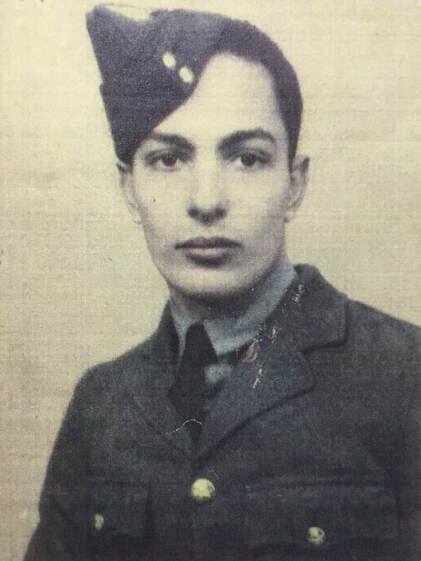John (Jack) Desmond CrawfordOwn recollections supported by Heather Esiri (daughter)
|
I was born in Lucea, Jamaica in 1923. We heard about the outbreak of the war from the BBC and newspapers like the Gleaner. That’s when I joined the Jamaican Home Guard in Kingston. At the time, I was working in the St Anne’s Bay, Labour Office. In 1944, I volunteered to train as ground crew for the RAF to help the war effort.
I travelled in a troop ship from Jamaica to New York where our ship joined a convoy to Glasgow. It took 3-4 days to get to New York and a couple of weeks to get to England. We were in a 20 ship convoy. The only thing we were afraid of was being torpedoed. On our arrival we were transported to RAF Hunmanby Moor, Filey, East Yorkshire for our initial training. The weather was freezing. I’d never seen snow before and on my first morning I slipped on the ice in my 'hob nailed' boots! Our training at Filey was for six weeks. Shortly before Christmas 1944, I developed bronchitis, so I was moved to a convalescent home on the outskirts of Skipton, where we were very well looked after. This is where I spent my first Christmas in England. I spent about a week and a half at the convalescent home. I remember ENSA (Entertainments National Service Association) coming in a couple of times to entertain us. Whilst convalescing we had to wear blue suits with white shirts and red ties. We were easily recognised in the town. Local people couldn’t do enough for us and were always offering to buy us drinks. Over Christmas we had everything, despite the rationing - turkey, Christmas pudding, the lot! It was tough going back to camp rations afterwards. When I recovered, I completed my initial training, then proceeded to the Number 12 School of Technical Training for ground crew and technicians at RAF Melksham. The only time I was issued with live ammunition was there when I was on guard duty in 1945. There was a report that some German POWs had escaped from a camp in South Wales. When the war ended, I worked in the Dispersal Unit at Hednesford, Cannock Chase. I made out the demob papers for a couple of months. We eventually left by ship in 1946. We stopped off first in Trinidad then went on to Jamaica. Our landing base was Port Royal. Everyone was searched as they disembarked. They confiscated so many pistols, guns, knives; a complete armoury! We were put into trucks and demobbed. We were given an allowance of about £25. Between 1946 and 1953 I worked for Customs and Excise in Kingston. In 1953 I returned to the UK to work as an apprentice for the De Havilland Aircraft Company in Hatfield. Following two comet crashes, the company was forced to make redundancies. I was made redundant after just 6 weeks. I signed on with the RAF the next day. With the £50 bonus I received for signing on, I paid for my wife, Gloria and our two young children to join me in 1955. This was one of the happiest times of my life, doing a job I enjoyed and was interested in. I enjoyed a long and successful career in the RAF, gaining expertise in designing and building instrument test equipment and rising to the rank of Chief Technician. I also used to enjoy using my artistic skills to create large scale, themed backdrops for events and social occasions in the Sergeant’s mess at RAF Sealand. I remember making a 12ft replica of the RAF memorial, with the eagle on the plinth, celebrating the 60th Anniversary of the RAF. It was all made out of large pieces of polystyrene. One year, I also designed the RAF float for the Lord Mayor’s Parade. I am particularly proud of my four medals including my Long Service medal and my B.E.M gained in 1974 in recognition of my achievements in the RAF. Sadly my wife, Gloria died in 1996 but I am the proud father of Jackie, Robert, Heather, Sue and Pamela. I also have 6 grandchildren and 2 great granddaughters who have inherited my love of nature, cooking skills and artistic flair. John's service number was 715186. |
|
RAF WW2 recruits
Discover more stories about the Caribbean RAF personnel who trained at Filey.
|
Servicemembers
Read further stories about servicemembers of African descent in the East Yorkshire area.
|
